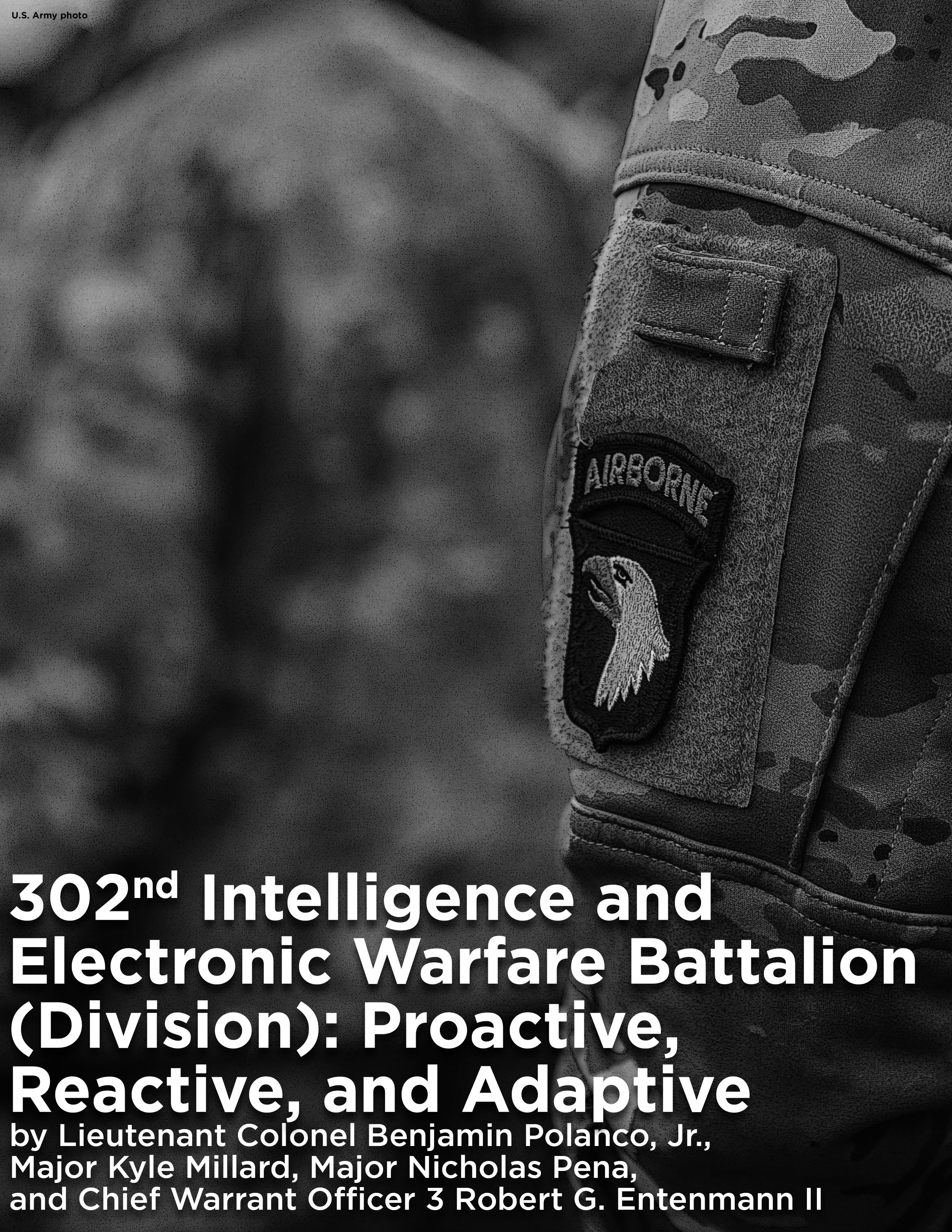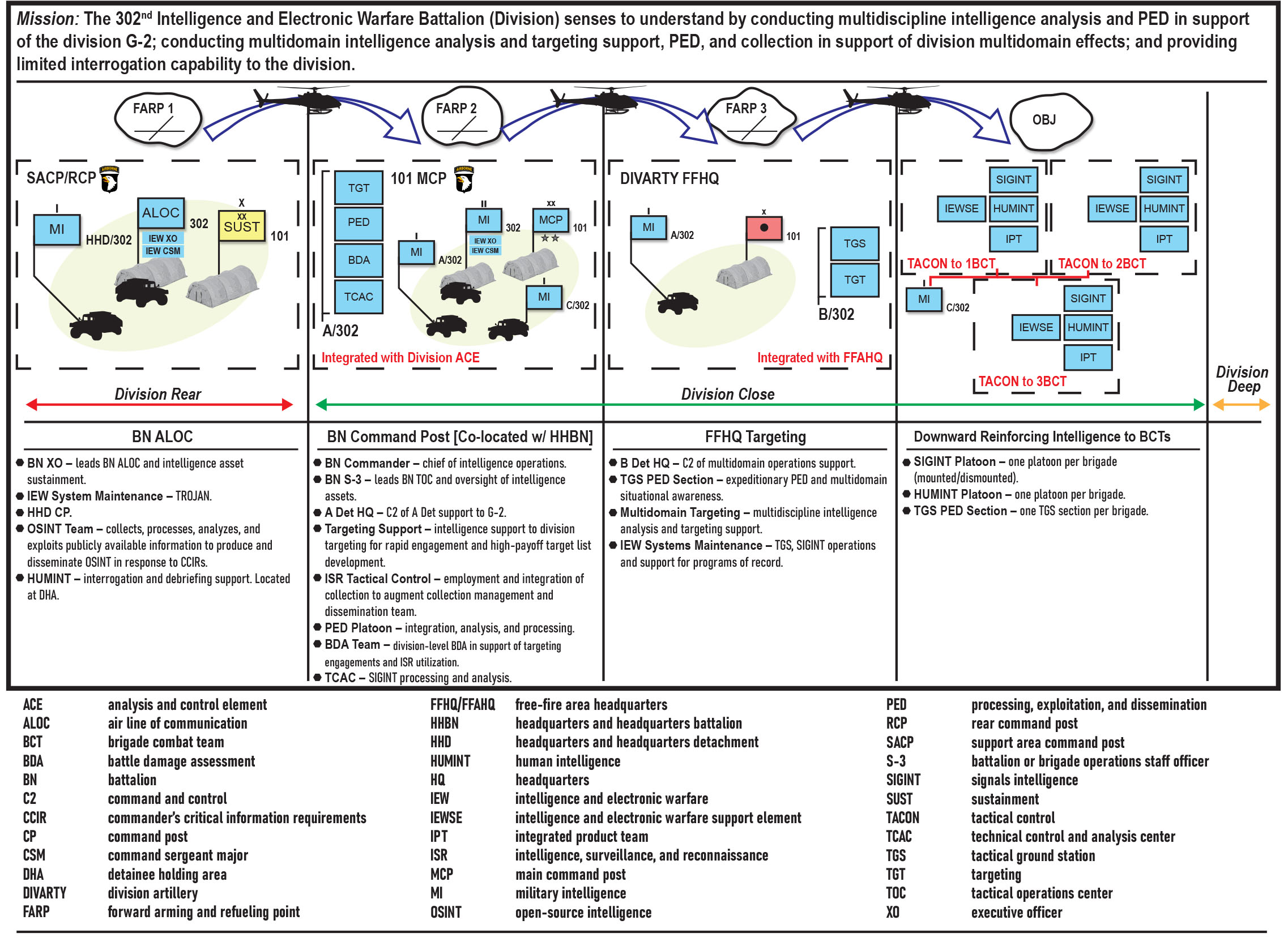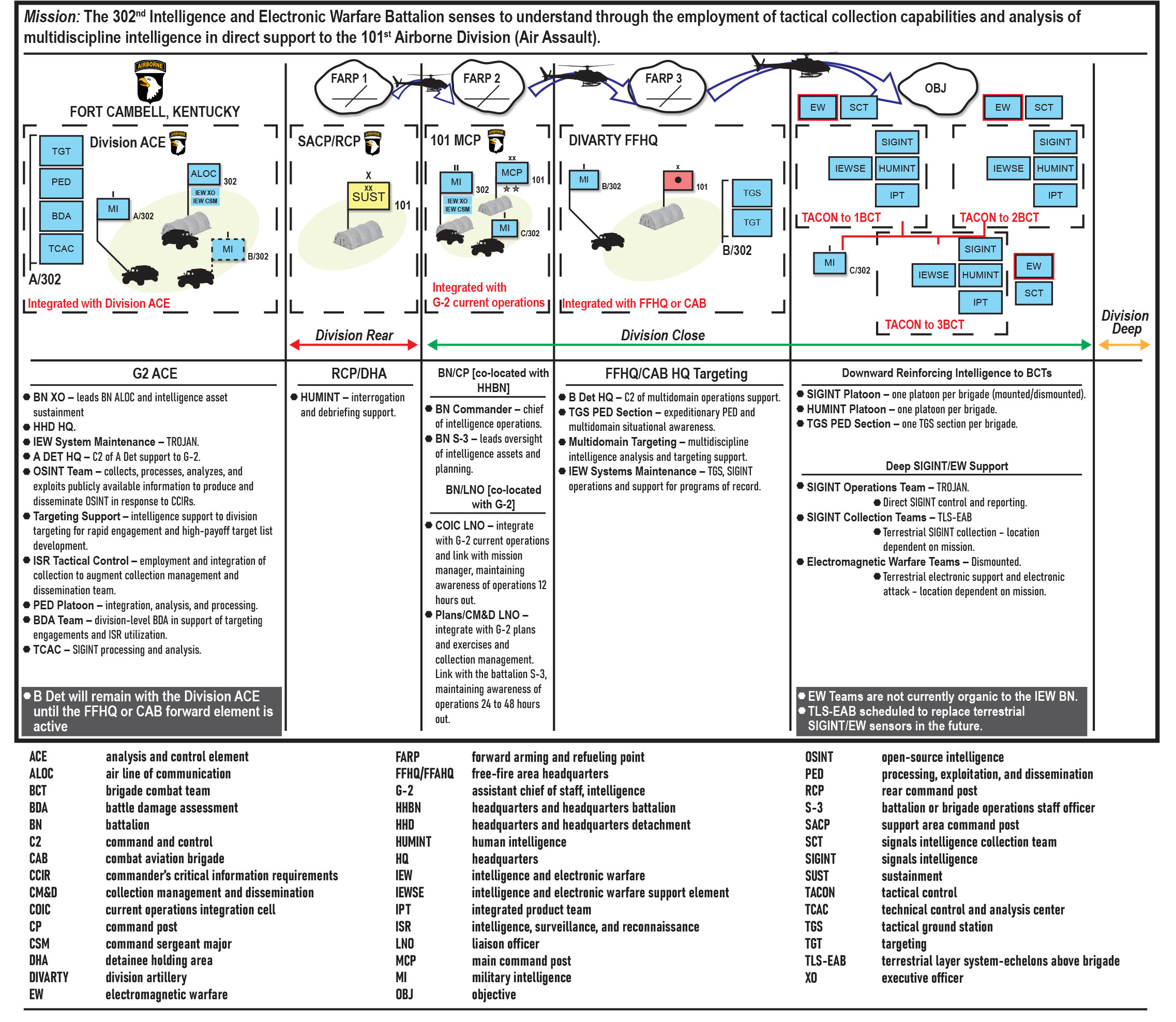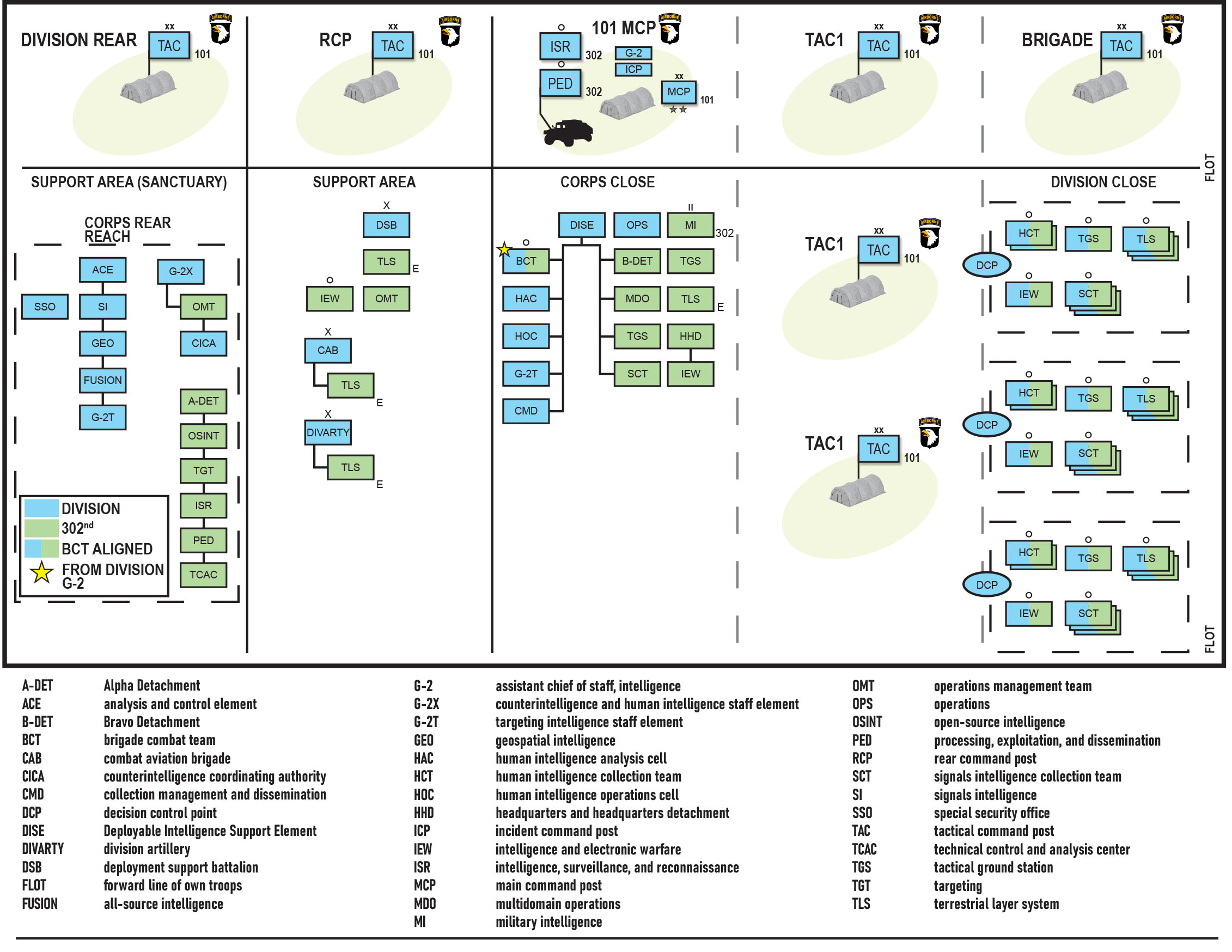302nd Intelligence and Electronic Warfare Battalion (Division): Proactive, Reactive, and Adaptive
Introduction
The 302nd Intelligence and Electronic Warfare (IEW) Battalion (Division) participated in Warfighter Exercise (WFX) 24-05 with the 101st Airborne Division (Air Assault), marking a significant milestone in the unit’s evolution and integration. As a recently activated battalion, the 302nd IEW Battalion faced the dual challenge of refining its operational concepts while addressing the limitations of its force structure and capabilities. This article delves into the journey through the initial preparations, the obstacles encountered, and the subsequent adjustments to the battalion’s operational concepts and force structure. We will examine the evolution of the battalion’s proactive operational concepts, the reactive steps taken to define key IEW battalion roles and responsibilities supporting division intelligence efforts, and the adaptive intelligence processes and production required for large-scale combat operations on the road to Army 2030 and 2040.
Proactive: Operational Concepts
Due to the rapid expansion of IEW battalions within expeditionary-military intelligence brigades (E-MIBs) and a lack of supporting doctrine, the 302nd IEW Battalion has proactively taken steps, aided by its superior commands and staff, to codify and deploy operational concepts in space and time. These concepts provide the necessary foundational framework while staying fluid to evolve with current Army initiatives such as Total Army Analysis 25-29, Army Structure 2025-2029, Transformation in Contact, Command and Control (C2) Fix, and doctrine relating to large-scale combat operations and multidomain operations.
Operational Concept One–Forward Deployed. Figure 1 below illustrates the 302nd IEW Battalion’s primary operational concept with the intent to support the 101st Airborne Division’s unique capability of long-range, large-scale air assault. Long-range, large-scale air assault is a concept in development whose objective is to move a mobile brigade combat team (BCT) 500 nautical miles in one period of darkness.1 The dispersion of the forward detachments and headquarters would ensure intelligence support within the G-2, division artillery, and rear command post.
Figure 1. 302nd Intelligence and Electronic Warfare Battalion (Division) Primary Operational Concept (figure adapted from author original)
Operational Concept Two–Reach Capable. Figure 2 depicts an alternate operational concept for the 302nd IEW Battalion’s intelligence operations occurring both forward and within reach. Simultaneously displaced efforts ensure the intelligence requirements are met. Disaggregation may cause an unwanted duplication of effort and/or a lack of shared understanding. Ensuring roles and responsibilities are properly codified between the division G-2 and the battalion, both for primary intelligence operations and alternate- and contingency-level battle drill events is essential. Maintaining the division’s battle rhythm and disseminating finalized intelligence below and above echelon will garner success within a properly defined relationship.
Figure 2. 302nd Intelligence and Electronic Warfare Battalion (Division) Alternate Operational Concept (figure adapted from author original)
Emerging technologies and cloud-based initiatives are all bandwidth intensive and require sufficient data transport to provide adequate download and upload speeds to maintain intelligence production that is efficient, effective, and timely. Reach capabilities ensure that the combined 101st Airborne Division G-2 and 302nd IEW Battalion intelligence teams are employed while reducing the division’s forward footprint. The relationship between the number of Soldiers utilizing systems and the bandwidth necessary to maintain effective employment is easy to understand. The art of employing reach capabilities is ensuring the right team members are forward to understand and interpret the results of the data displayed rapidly.
Over the past year, the 302nd IEW Battalion flexed personnel from various command post (CP) locations with mixed results due to changes in programs of record, bandwidth issues, and other mission requirements. This resulted in too many variables to solidify the proper balance for all operations. Thus, mission-dependent requirements remain the critical planning element for success and require constant communication between the division intelligence enterprise and the battalion to place capabilities effectively in support of analysis and collection requirements.
One lesson learned from this exercise is that IEW battalions must maintain multiple operational concepts to ensure divisions receive sufficient support. These concepts are based on the nature of the operation being conducted, and they will vary across battalions based on support requirements.
A second lesson learned is the need to base organic data transport needs on the number of bandwidth-heavy cloud-based initiatives. Throughout the exercise, all capabilities hinged on access to the division’s tactical network, SECRET Internet Protocol Network (SIPRNET), and Joint Worldwide Intelligence Communications System. With no organic data transport at the battalion level, using the division’s network is imperative. This would also be true if brigades were integrated into the conflict. The 302nd IEW Battalion currently does not have an integrated tactical network capability or limited lower tactical internet capability, making it reliant on the supported unit for communications. The primary tools used by all sections were the Army Intelligence Data Platform (AIDP),2 Maven Smart System (MSS),3 and the U.S. Army Intelligence and Security Command (INSCOM) Cloud Initiative.4
A secondary issue became the lack of training on these systems. MSS was implemented en masse a week before the exercise started, leaving insufficient time for analysts and users to become proficient with the system. AIDP was used in the past but not on a large scale, leading to users learning the system in real time during the WFX. Additionally, the initial deployment of Foundry-based applications, such as Sim Box and Estimates App, into AIDP led to rapid learning requirements and workflow changes before the mission’s execution.5
Reactive: Key Roles and Responsibilities
Throughout WFX 24-05, the battalion defined and refined the roles and responsibilities of key leaders and teams.
IEW Battalion Commander. The first was the role of the IEW battalion commander. The battalion experimented with various concepts on where and how to employ the commander to codify the role of chief of intelligence operations. We learned that the battalion commander must remain integrated with the division G-2 and collection manager to provide proper C2 of the battalion’s intelligence capabilities. Additionally, attendance at the assessment working group, collection working group, and operations synchronization meeting aided the battalion in defining and planning intelligence support for the operation. This ensured maximum asset employment and made it possible to identify gaps and seams in coverage, specifically in the vicinity of the brigade to the division intelligence handover line. Once these were identified, the commander could best advise how to facilitate requests for assets from higher headquarters.
Command Group. The battalion S-3 integrates with battalion staff and the division G-35/G-5 to ensure that organic assets are appropriately tasked to reflect the current collection guidance from the collection manager and G-2. This provides better coordination of movement with friendly force operations. The executive officer and command sergeant major remain with the battalion CP to integrate with the higher headquarters and ensure support to the battalion. They take the lead in ensuring personnel and equipment replacements are reported and incorporated into the formation to minimize capability degradation. The executive officer runs the battalion CP in the commander’s absence and ensures the commander receives updates when time and the commander’s return permits. Ideally, the battalion CP is co-located with the division G-2.
Mission Manager. The mission manager position is not assigned but was created by the battalion out of necessity. The mission manager looks at information collection assets, named areas of interest, and priority intelligence requirements as encapsulated in the G-2 collection management and dissemination section’s intelligence, surveillance, and reconnaissance (ISR) plan and determines which specific collection matrix ISR lines the processing, exploitation, and dissemination (PED) team will support. The G-2 collection management and dissemination section determines the allocation of assets against specific collection focus areas such as situation development, target development, and battle damage assessment (BDA). The mission manager then directs PED efforts toward those focus areas. Finally, the mission manager briefs the collection manager or the IEW battalion S-3 no later than 2200 the day before execution to confirm allocation and emphasis.
Intelligence, Surveillance, and Reconnaissance Assessments Team. The ISR assessments team determines ISR effectiveness and conducts BDA; however, with only a five-person team, BDA became the sole focus during the exercise. Currently, the Army does not have doctrine or procedures to follow for conducting BDA, which means the responsibility for this process and how to execute it falls on each division. Initially, the G-2 used AIDP to display BDA, but as the exercise progressed, several flaws in the system prevented an accurate tracking mechanism. This resulted in the G-2 switching to analog battle tracking using Microsoft Excel on shared Microsoft Teams over SIPRNET. Utilizing Microsoft Office 365 on SIPRNET enabled real-time sharing and made the product readily accessible to all within the G-2 and on the current operations integration cell floor; however, research is ongoing for a system to streamline and standardize BDA reporting and tracking.
Tactical Ground Station PED Section. The Tactical Ground Station PED section in Bravo Detachment is similar to Alpha Detachment’s PED platoon, except it is expeditionary. The Reach Capable Operational Concept, used during this exercise, integrated Bravo Detachment PED with Alpha Detachment PED at the analysis and control element. This integration allowed more personnel to exploit both organic and echelons above division assets collecting within the area of operations. It also enabled a stable pipeline to conduct PED without network loss or latency interruptions as both detachments’ PED operated under the same bandwidth constraints. The Tactical Ground Station PED section can also operate comparably to Bravo Detachment’s multidomain operations targeting section. It can be attached to the division artillery or the division main command post, providing PED support for the same functions the targeting team would execute.
Charlie Company–MI Company (Division Support). As the IEW battalion’s military intelligence company providing division support, Charlie Company’s role in the exercise offered a unique insight into potential future challenges for the division as it employs this newly established company. The IEW battalion staff must invest time to ensure proper employment and command support relationships between the company, battalion, and division during operations. As collectors for the division working in the division’s brigade combat teams’(BCTs’) battle spaces, support is crucial to accomplish their mission.
As an additional challenge, the 101st Airborne Division is participating in the C2 Fix initiative.6 Due to their participation, intelligence generation through PED-specific procedures is manually produced and hand-delivered by the division analysis and control element. The BCTs operate on Sensitive but Unclassified–Encrypted networks, which limits the teams’ ability to send classified data back to the division. During the exercise scenario, this limitation had minimal impact; however, implementing Charlie Company assets moving forward within the C2 Fix construct will likely require changing the battalion’s modified table of organization and equipment (MTOE). Alternatively, the battalion must source commercial- or government-off-the-shelf solutions to ensure connectivity.
Another crucial issue for the 302nd IEW Battalion is the logistics behind asset replacement for Charlie Company. During WFX 24-05, the 302nd IEW Battalion relied on the 101st Airborne Division and 525th E-MIB to provide critical assets and personnel replacement after battlefield losses. The 525th E-MIB works in direct partnership with XVIII Airborne Corps, which allowed it to streamline asset replacement through standard reporting and ensured minimal gaps in collection coverage inside the division and corps areas of operation. To avoid any degradation to operations, the IEW battalion must report asset and personnel replacement requirements to the E-MIB and its supported division.
Finally, the 101st Airborne Division is developing a concept to habitually align some Charlie Company assets to support the BCTs moving forward. The plan will allow the BCTs to integrate these capabilities through training and provide predictability before operations. This initiative, in turn, will require an analytical support element directly aligned with the BCTs to reside in the division G-2. Figure 3 depicts the 101st Airborne Division’s plan to habitually align Charlie Company, 302nd IEW Battalion assets within the division’s intelligence warfighting function supporting framework.
Figure 3. 302nd Intelligence and Electronic Battalion (Division) and G-2 Habitual Alignment Framework (figure adapted from author original))
Adaptive: Intelligence Processes versus Production
Emerging technologies, cloud-based initiatives, and the sunsetting of legacy mission command and intelligence transport, sensors, systems, and processors demand that the 302nd IEW Battalion remains vigilant to procure, incorporate, utilize, and maintain all programs of record both internal and external to the MTOE. These changes to mission command and intelligence architecture are currently experimental, in development, and ultimately extensive; however, doctrinal intelligence processes will remain valid throughout. Intelligence production requirements must also remain adaptive to meet the desired outputs of echelons below, at, and above division.
These changes present a real and significant problem for division intelligence operations, including challenges for–
- Information collection synchronization and management.
- PED.
- Common intelligence picture.
- Decide, detect, deliver, and assess.
- Sensor to shooter.
- Dissemination of finalized intelligence.
- Situational development, target development, and BDA.
Adaptive solutions have been and will continue to be developed to mitigate these problems; however, legacy systems are still included in the MTOE for the division and the IEW battalion (division) while new and emerging technologies continue to be developed and deployed.
Cloud-based solutions, particularly AIDP, have broadened the ability of division intelligence operations to share and collaborate at echelons above division. Since it is cloud-based, using the AIDP training environment to its full potential requires significant planning, scheduling, and requests for support. Nevertheless, the 101st Airborne Division G-2 and 302nd IEW Battalion Soldiers were trained effectively within weeks and then battle-tested over several large-scale training exercises. With prioritized division intelligence system efforts still in development, the 101st Airborne Division and the 302nd IEW Battalion have utilized this known deficiency to deploy AIDP boldly and effectively, proving its value to U.S. Army Forces Command (FORSCOM), INSCOM, and the U.S. Army Training and Doctrine Command (TRADOC).
Prior planning is essential for large-scale exercises like WFX 24-05 but has become significantly more difficult due to emerging technologies and cloud-based initiatives. Intelligence programs of record currently fielded and in development are designed to increase ease of use and require little to no maintenance. However, significant changes to the intelligence architecture may require significant problem-solving skills during execution. During WFX 24-05, the 302nd IEW Battalion deployed a small data management team to identify these problems before execution and to formulate workflows within and to support the intelligence process. The data management team was also responsible for maintaining communication with the AIDP field service engineers to ensure present and persistent data flow and, more specifically, an uninterrupted message traffic data flow.
One of the data management team’s workflows targeted the employment of AIDP as a collaboration tool. It is essential to know that the interdependency of AIDP tools with other tools (e.g., Gaia, Graph, Dossier) is an architecture. The data management team developed a map architecture and standard operating procedures for each tool’s intended purpose, enabling the 101st Airborne Division G-2 and 302nd IEW Battalion analysts to navigate AIDP’s internal products for collaboration and data sharing. Additionally, to compensate for the AIDP training stack’s inability to peer with MSS and its Target Workbench application,7 the data management team developed an AIDP Graph to house the high-payoff target list targeting priorities according to air tasking order day. Pre-generated objects (high-payoff target list-specific equipment) streamlined object development and confirmation status to enable an efficient and effective targeting process.
Weeks before the WFX execution, the data management team also developed applications with AIDP field service engineers to parse the U.S. Message Traffic Format (USMTF). The SIM Box application yielded the best results for parsing USMTF, but it had some limitations, such as message time lapses from batched message flow. Through their efforts, AIDP’s ability to parse USMTF produced the best visual fidelity of enemy movement during a large-scale exercise. The Mission Command Training Program projects that 140,000 to 160,000 messages are generated during a ten-day WFX. However, due to the appropriate use of intelligence collection assets above division, WFX 24-05 generated over 350,000 messages, and AIDP displayed correct object icons for hundreds of emplaced obstacles and defensive positions. Proper parsing of USMTF reconnaissance exploitation reports led to this result, but duplicate reports, specifically BDA, may have contributed to the total. These solutions, developed to avoid problems or in the absence of existing solutions, were recorded by Mission Command Training Program observer coach/trainers and relayed to the programs of record for development as well as to FORSCOM, INSCOM, and TRADOC.
Report writing applications do not currently exist within Palantir’s “Family of Systems,” which includes AIDP-Cloud, AIDP-Tactical Edge, MSS, and Capability Drop-1. These systems can send USMTF-generated messages, such as target intelligence data and enemy situation reports; however, reports that provide situational development to echelons below, lateral to, and above division do not exist. During WFX 24-05, the 101st Airborne Division G-2 and 302nd IEW Battalion utilized AIDP’s Dossier9 tool,to develop the intelligence running estimate, which was used to finalize an intelligence summary for publication.
Finally, these emerging technologies and cloud-based initiatives provide near-perfect graphic representations of the operational environment. Often, these graphics are data-intensive, and disseminating them using traditional primary, alternate, contingency, and emergency (PACE) methods can be risky. It is essential, therefore, to remember the need for a simple text format—for example, Variable Message Format—when designing an effective PACE plan within a C2 Fix environment. A simple text format enables echelons to prepare intelligence for dissemination through multiple means, whether chat, email, data packages, or voice communications.
Conclusion
WFX 24-05 served as a test and a catalyst for the 302nd IEW Battalion’s operational development. The exercise highlighted critical shortfalls, such as only partial integration of the battalion staff and detachments, insufficient equipment and personnel, and the challenges posed by reliance on external network services. However, it also underscored the battalion’s ability to adapt and evolve its operational concept to meet the demands of the 101st Airborne Division’s split operations. The invaluable lessons learned from WFX 24-05 drive home the battalion’s need to develop multiple operational concepts, ensure comprehensive training on key systems, and integrate more robust communication capabilities. As the 302nd IEW Battalion continues to refine its strategies and capabilities, it is better positioned to provide critical intelligence support in increasingly complex and dynamic operational environments.
Endnotes
1. Josh Luckenbaugh, “AUSA News: Army Practices New Air Assault Concept Without New Helicopter,” Army News, National Defense, October 15, 2024, https://www.nationaldefensemagazine.org/articles/2024/10/15/army-practices-new-air-assault-concept-without-new-helicopter.
2. “Army Intelligence Data Platform (‘AIDP’),” Palantir Technologies, Inc., https://www.palantir.com/assets/xrfr7uokpv1b/7JAWiSA6yA5MLDAD1AsX7l/c256437b1c29bad5747633123957b4b7/AIDP_AUSA__2_-updated2.pdf.
3. “Maven Smart System,” The Missile Defense Advocacy Alliance, 2025, https://missiledefenseadvocacy.org/maven-smart-system/.
4. Loren Blinde, “INSCOM Posts Cloud Platform RFI,” Biz Opps, Intelligence Community News, August 3, 2021, https://intelligencecommunitynews.com/inscom-posts-cloud-platform-rfi/.
5. Department of the Army, Field Manual 2-0, Intelligence (Washington, DC: Government Publishing Office, 01 October 2023), B-3. The Foundry Intelligence Training Program is a critical enabler for Army global readiness. It provides resources to train military intelligence Soldiers and civilians at the strategic, operational, and tactical levels.
6. Michelle K. Donahue, “The C2 Fix Initiative: What it Means for Sustainment Forces,” U.S. Army website, January 22, 2025, https://www.army.mil/article/282485/the_c2_fix_initiative_what_it_means_for_sustainment_forces.
7. “Target Workbench: Collaborate Across the Target Lifecycle,” Palantir Technologies, Inc., 2023, https://www.palantir.com/assets/xrfr7uokpv1b/1IqzwzpemtBSm98TNCczao/49bbc30cbec4d2d4d189ab27bd07376c/Palantir_Target_Workbench___1_.pdf.
8. Admin, “What is Network Peering? Definition, Types, and Benefits,” EDGE DC (blog), October 24, 2023, https://edge.id/articles/what-is-network-peering.
9. “Dossier,” Palantir Technologies, Inc., 2025, https://www.palantir.com/offerings/defense/secure-collaboration/capabilities/#dossier.
LTC Benjamin Polanco, Jr. is the Commander, 302nd Intelligence and Electronic Warfare (IEW) Battalion (Division), 525th Expeditionary-Military Intelligence Brigade (E-MIB). He began his career as a military intelligence (MI) officer detailed to the infantry and served as a mechanized infantry platoon leader and executive officer while assigned to 2nd Battalion, 7th Cavalry Regiment and 1st Battalion, 12th Cavalry Regiment, 3rd Brigade Combat Team (BCT), 1st Cavalry Division. LTC Polanco has served in various staff and command intelligence positions within 1st Infantry Division (Military Transition Team); 717th MI Battalion (National Security Agency-Texas); 4th Battalion, 10th Special Forces Group (Airborne); 101st Airborne Division (Air Assault); North Atlantic Treaty Organization Rapid Deployable Corps-Italy; and U.S. Army Central. He most recently served as the Assistant Chief of Staff G-2 for the 1st Theater Sustainment Command. LTC Polanco has deployed to Afghanistan, Africa, Iraq, and Saudi Arabia.
MAJ Kyle Millard is the executive officer, 302nd IEW Battalion (Division), 525th E-MIB. He has previously served as the G-2 analysis and control element chief for the 101st Airborne Division (Air Assault); the S-2 for 2nd BCT, 101st Airborne Division; as a MI company commander and battalion S-2 in 1st BCT, 101st Airborne Division. He holds a bachelor’s degree in global security and intelligence from Embry Riddle Aeronautical University and a master’s degree in business and organizational security management from Webster University.
MAJ Nicholas Pena is the operations officer, 302nd IEW Battalion (Division) 525th E-MIB. He has previously served as the battalion S-2 for 2nd Battalion, 7th Infantry Regiment, 1st Armored BCT, 3rd Infantry Division; as the brigade assistant S-2 for 1st Armored BCT; and as an intelligence observer coach/trainer with 1st Army East. He holds a bachelor’s degree in business management from the University of Central Florida and a master of business administration from Vanderbilt University
CW3 Robert G. Entenmann II is the S-3 intelligence operations chief, 302nd Battalion (Division), 525th E-MIB. He currently serves as the lead data manager. Before his current assignment, he deployed with the 101st Airborne Division (Air Assault) to Poland as the Task Force-101 Division Tactical Command Post G-2 fusion officer in charge. He holds a bachelor’s degree in political science from Adelphi University and he is a recent graduate of the Master Intelligence Data Strategy Course.



